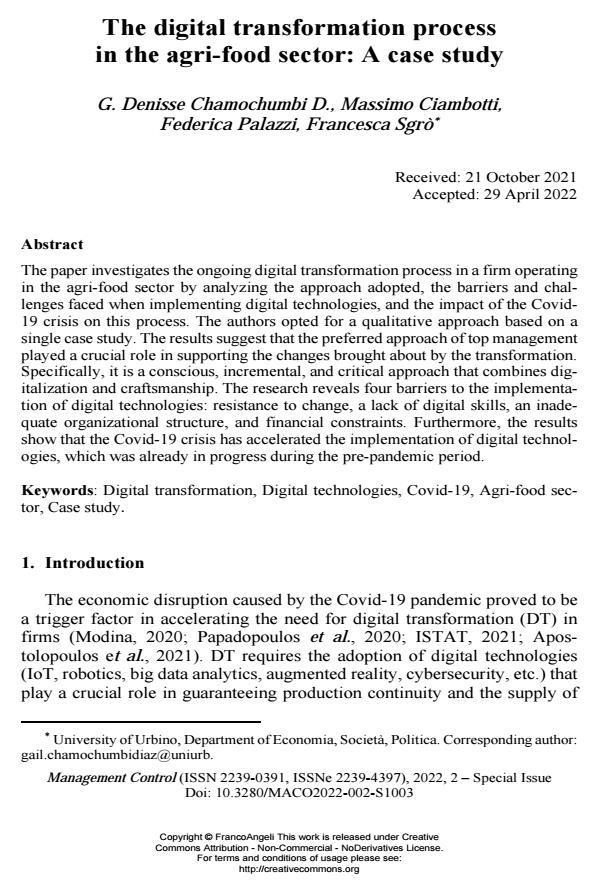The digital transformation process in the agri-food sector: A case study
Titolo Rivista MANAGEMENT CONTROL
Autori/Curatori G. Denisse Chamochumbi D., Massimo Ciambotti, Federica Palazzi, Francesca Sgrò
Anno di pubblicazione 2022 Fascicolo 2022/2 Suppl.
Lingua Inglese Numero pagine 28 P. 43-70 Dimensione file 284 KB
DOI 10.3280/MACO2022-002-S1003
Il DOI è il codice a barre della proprietà intellettuale: per saperne di più
clicca qui

FrancoAngeli è membro della Publishers International Linking Association, Inc (PILA)associazione indipendente e non profit per facilitare (attraverso i servizi tecnologici implementati da CrossRef.org) l’accesso degli studiosi ai contenuti digitali nelle pubblicazioni professionali e scientifiche
The paper investigates the ongoing digital transformation process in a firm operat-ing in the agri-food sector by analyzing the approach adopted, the barriers and challenges faced when implementing digital technologies, and the impact of the Covid-19 crisis on this process. The authors opted for a qualitative approach based on a single case study. The results suggest that the preferred approach of top management played a crucial role in supporting the changes brought about by the transformation. Specifically, it is a conscious, incremental, and critical approach that combines digitalization and craftsmanship. The research reveals four barriers to the implementation of digital technologies: resistance to change, a lack of digi-tal skills, an inadequate organizational structure, and financial constraints. Fur-thermore, the results show that the Covid-19 crisis has accelerated the implemen-tation of digital technologies, which was already in progress during the pre-pandemic period.
Parole chiave:Digital transformation, Digital technologies, Covid-19, Agri-food sec-tor, Case study.
- “Sustainab-lization”: Sustainability and Digitalization as a Strategy for Resilience in the Coffee Sector Barbara Iannone, Giulia Caruso, in Sustainability /2023 pp.4893
DOI: 10.3390/su15064893 - Digital Maturity of Administration Entities in a State-Led Food Certification System Using the Example of Baden-Württemberg Sabrina Francksen, Shahin Ghaziani, Enno Bahrs, in Foods /2025 pp.1870
DOI: 10.3390/foods14111870 - The impact of digitalisation on professional football clubs Fabio Nappo, Alessandra Lardo, Maria Teresa Bianchi, Federico Schimperna, in MANAGEMENT CONTROL 2/2023 pp.117
DOI: 10.3280/MACO2023-002006 - Shedding light on the preconditions for circular economy: Evidence from SMEs in the agri-food sector Francesco Avallone, Costanza Di Fabio, Shekerta Aliu, Elisa Roncagliolo, in MANAGEMENT CONTROL 3/2024 pp.141
DOI: 10.3280/MACO2023-003007
G. Denisse Chamochumbi D., Massimo Ciambotti, Federica Palazzi, Francesca Sgrò, The digital transformation process in the agri-food sector: A case study in "MANAGEMENT CONTROL" 2 Suppl./2022, pp 43-70, DOI: 10.3280/MACO2022-002-S1003